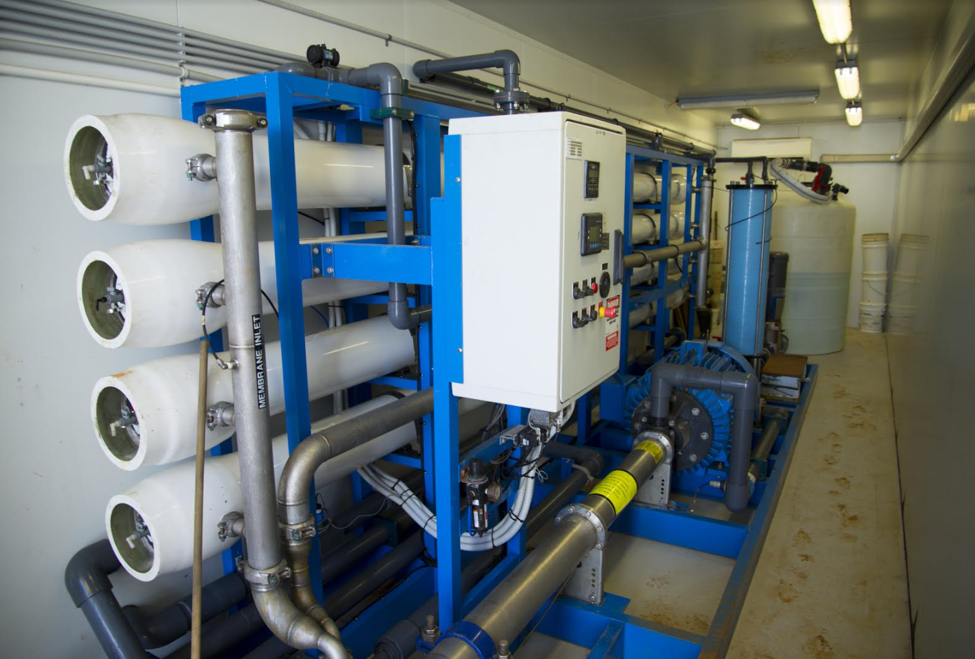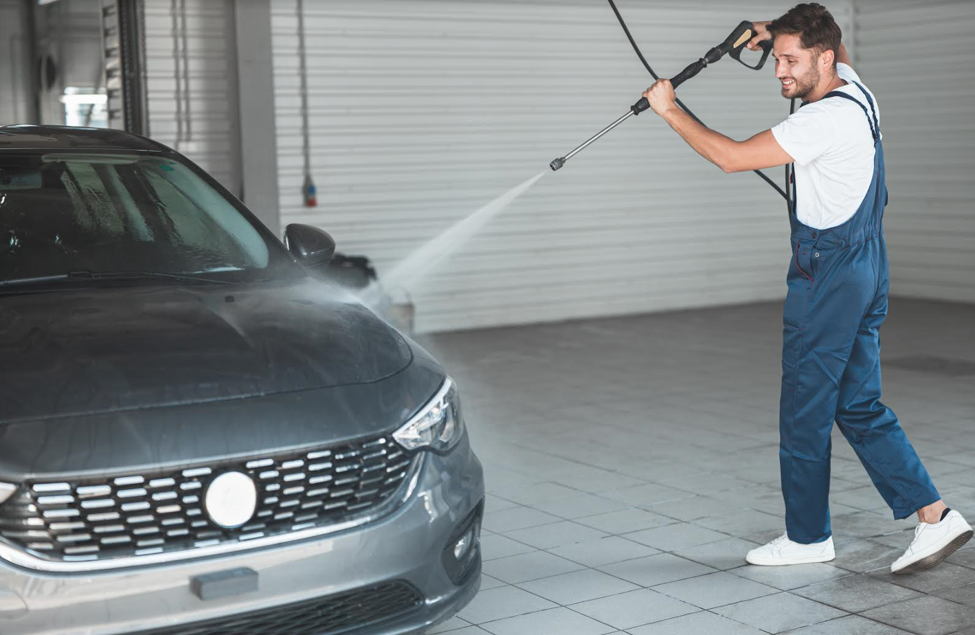What Are Reverse Osmosis Systems for Car Washes?
If you have hard water at your car wash, water stains can be an issue. Hard water has various minerals and calcium in it. When it dries, it leaves white spots on the vehicle that are not very attractive.
Even if you sell your customers the right car wash supplies to dry and polish their vehicles, not all of your customers are going to want to have to hand dry their vehicles every time they wash them. One effective way to deal with hard water is by installing a reverse osmosis system at your car wash.
What Is Reverse Osmosis?
 The best way to think about reverse osmosis is it is a type of water filtration method. The water is forced through a semi-permeable membrane that filters out unwanted particles, minerals, and calcium from the water. All of those things are flushed down the drain, leaving clean and pure water.
The best way to think about reverse osmosis is it is a type of water filtration method. The water is forced through a semi-permeable membrane that filters out unwanted particles, minerals, and calcium from the water. All of those things are flushed down the drain, leaving clean and pure water.This is why reverse osmosis systems are very popular with homeowners and business owners who want clean drinking water. The process used also makes the water taste better for drinking purposes.
Reverse osmosis can be used to purify the water used to wash cars at your car wash and result in spot-free drying for your customers. It will remove out all of the impurities in hard water so your customers won’t have to worry about white spotting on their vehicles again.
How Does Reverse Osmosis Work?
In general, pressure is applied to the water to force it through the semi-permeable membrane that is greater than the osmotic pressure. During this process, unwanted particles are removed. The end result is unwanted particles are kept on the pressurized side of the semi-permeable membrane and pure water is passed through to the other side, where it can then be used for drinking water or to rinse soap off of the cars at your car wash.
Why Use a Reverse Osmosis System at a Car Wash?
If you are looking to make the car wash rinsing and drying processes easier for your customers, then you should consider getting a reverse osmosis system. As we talked about, since the minerals and calcium are removed from hard water, it will not leave those annoying white spots on the vehicle when they dry if your customers decide to not dry and detail their vehicles.
The quality of your water is also important to keep your car wash operating successfully. Customers will grow tired of white spots on their vehicles and having to spend more time detailing their cars after washing them when they don’t really want to do this added task.
To be honest, most people just want to wash their cars and go. They don’t want to have to dry it off with microfiber towels or put extra work in, especially if they’ve just worked an 8-hour day.
Additionally, the quality of your water affects your hand car wash equipment. The minerals and calcium in hard water can gradually create issues with its operations. Spray nozzles will start to clog as mineral and calcium deposits dry on them. As a result, you will need to replace spray nozzles more often than you would with a reverse osmosis system.
Furthermore, hard water cuts down on the effectiveness of car wash soaps because they reduce its effectiveness at removing dirt and debris from vehicles. You will need to use a larger amount of soap per wash to maintain effectiveness.
The same is true with hot wax treatments you offer your customers. Hard water affects the quality of the wax and its ability to adhere to the vehicle. You will also need to use a larger amount of hot water per wax cycle to deliver the “beading” effect on your customers’ vehicles.
As you probably guessed, without a reverse osmosis system at your car wash and with hard water, you will end up spending more on car wash soap and wax, which will cut into your profit margins.
What Are the Benefits of Installing a Reverse Osmosis System?
 Car wash owners and their customers will enjoy the benefits of a reverse osmosis system that include:
Car wash owners and their customers will enjoy the benefits of a reverse osmosis system that include:- Spot-free rinsing and spot-free drying. Since there are no minerals or calcium left in the water, you and your customers will never have to worry about white spots drying on vehicles again.
- Reduces the amount of car wash soap and wax needed. Since you don’t have to combat the effects minerals and calcium have on reducing the effectiveness of soaps and waxes, you can cut down on the amount used per wash and wax cycle. Your customers will still receive the results they demand too.
- Reduces your equipment maintenance expenses. You won’t have to worry about car wash spray nozzles and other hand car wash equipment not working as effectively from mineral and calcium deposits. As a result, you won’t have to spend money to replace them as often.
- Extends the useful lifespan of car wash nozzles and equipment. A side effect and bonus of reduced maintenance expenses is the prolonged use you can get from your spray nozzles and car wash equipment.
- Increased profits for your car wash. By cutting expenses and operating costs and keeping your customers happy with spot-free rinsing and drying, you will notice your profits will gradually increase. With the increase, you can reinvest the money into your car wash or make other equipment upgrades to stay competitive.
What Size Reverse Osmosis System Do Car Washes Need?
Reverse osmosis systems come in a variety of sizes with different features and options. Some car washes install individual reverse osmosis systems for each car wash bay. This can be somewhat expensive, as each system must meet the demands of the number of washes each bay generates for the car wash.
An alternative investment some car washes make is in a larger system to meet the demands of all of their car wash bays. The size of the system will determine how much mineral-free and calcium-free water can be produced per minute. If your demands are higher than the system output, then you will need a larger system to keep up with demand.
Additionally, some car washes install holding tanks where the treated water can be stored and refilled as their levels go down. The benefit of using holding tanks with a reverse osmosis system is the system can create treated water even when no one is washing their car.
Is the Cost of a Reverse Osmosis System Really Worth It?
 In the long run, investing in a reverse osmosis system for your car wash will pay off. Getting a system installed and up and running does require an investment. Yet, with the benefits you gain, over time, the system will pay for itself.
In the long run, investing in a reverse osmosis system for your car wash will pay off. Getting a system installed and up and running does require an investment. Yet, with the benefits you gain, over time, the system will pay for itself. Not to mention, you will be spending less money on replacement hand car wash equipment and car wash soaps and waxes.
For example, let’s say the cost to get a reverse osmosis system and have it installed costs $15,000. Before its installation, you were spending $2,000 a month on car wash soap, $1,500 on car wash wax, and $1,000 on car wash equipment parts and components.
After it is installed, you notice your monthly operating expenses have declined. You are now spending $750 a month on car wash soap, $500 on car wash wax, and $300 on car wash equipment parts and components. Overall, you are saving $2,950 a month.
If you were to divide this into the cost of the reverse osmosis system, you would see it would pay for itself in just a little over five months. After that, all of the savings you experience will increase your bottom line.
Please keep in mind the dollar values used here are just to show how investing in a reverse osmosis system can pay off in the long run and should not be taken as actual costs and savings.
As you can see, the benefits of investing in a reverse osmosis system for your car wash can be a good investment decision. Not only will your investment keep your customers happy and returning to your car wash, but it will also reduce your operating expenses.
To find great deals on car wash supplies, car wash materials, and hand car wash equipment parts and components, please feel free to explore our online store or contact Superior Car Wash Supply at 800-554-9274 today!
Source: